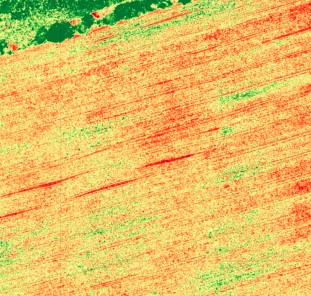From the report “Unmanned aerial vehicle canopy reflectance data detects potassium deficiency and green peach aphid susceptibility in canola“, of Dustin Severtson, Nik Callow, Ken Flower, Andreas Neuhaus, Matt Olejnik, Christian Nansen, published at Precision agriculture.
There is growing evidence that potassium deficiency in crop plants increases their susceptibility to herbivorous arthropods. The ability to remotely detect potassium deficiency in plants would be advantageous in targeting arthropod sampling and spatially optimizing potassium fertilizer to reduce yield loss due to the arthropod infestations.
Four potassium fertilizer regimes were established in field plots of canola, with soil and plant nutrient concentrations tested on three occasions: 69 (seedling), 96 (stem elongation), and 113 (early flowering) days after sowing (DAS). On these dates, unmanned aerial vehicle (UAV) multi-spectral images of each plot were acquired at 15 and 120 m above ground achieving spatial (pixel) resolutions of 8.1 and 65 mm, respectively.
At 69 and 96 DAS, field plants were transported to a laboratory with controlled lighting and imaged with a 240-band (390–890 nm) hyperspectral camera. At 113 DAS, all plots had become naturally infested with green peach aphids (Hemiptera: Aphididae), and intensive aphid counts were conducted.
Potassium deficiency caused significant:
- increase in concentrations of nitrogen in youngest mature leaves,
- increase in green peach aphid density,
- decrease in vegetation cover,
- decrease in normalized difference vegetation indices (NDVI) and decrease in canola seed yield.

UAV imagery with 65 mm spatial resolution showed higher classification accuracy (72–100 %) than airborne imagery with 8 mm resolution (69–94 %), and bench top hyperspectral imagery acquired from field plants in laboratory conditions (78–88 %). When non-leaf pixels were removed from the UAV data, classification accuracies increased for 8 mm and 65 mm resolution images acquired 96 and 113 DAS.
This study, which was conducted over one growing season, demonstrated that field regions containing K-deficient canola plants were accurately classified relative to K-sufficient plants using canopy reflectance data acquired from a six-band MCA. Highest classification accuracies were achieved at 65 mm resolution with very similar results whether back-ground pixels were removed or not.
The study supports findings that UAV-acquired imagery has potential to identify regions containing nutrient deficiency and likely increased arthropod performance.

